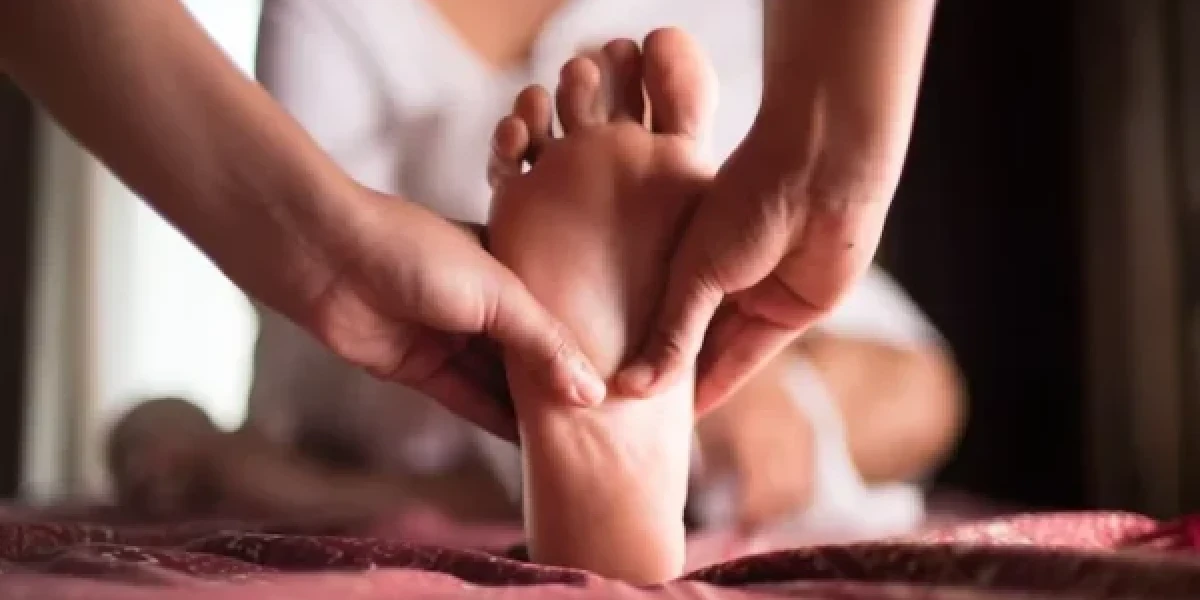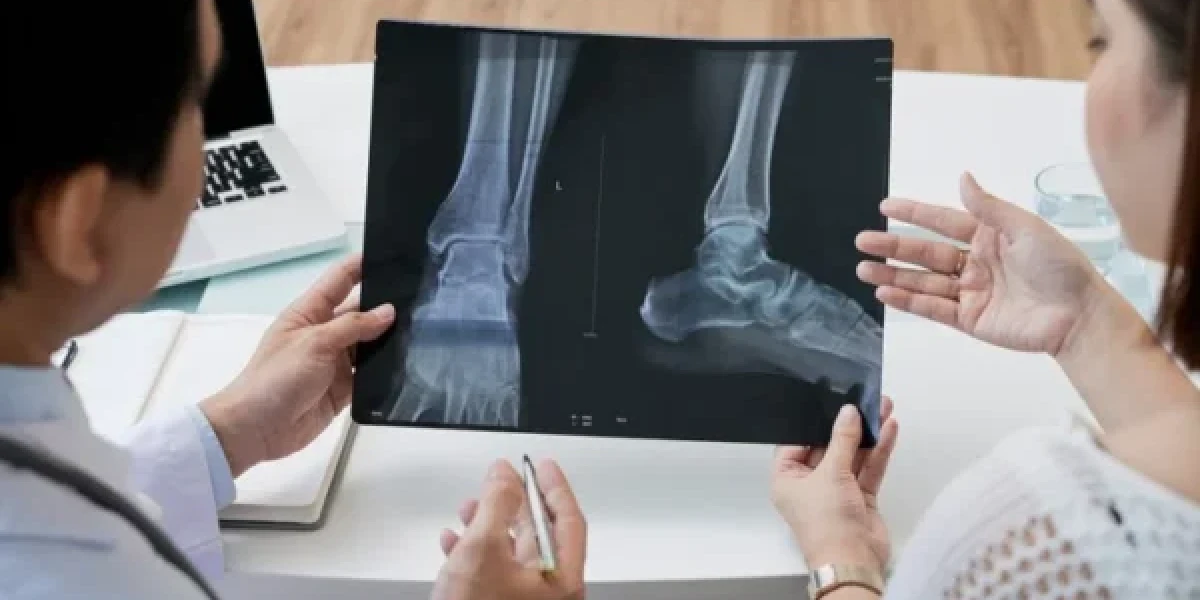Introduction
Reflexology: Stress is one of the most common and pervasive problems that people face in their daily lives. From work pressure to personal challenges, stress can affect our physical, mental, and emotional health in various ways. Stress can cause headaches, insomnia, anxiety, depression, and even chronic diseases. Therefore, finding effective ways to manage stress is essential for our well-being.
One of the natural and holistic ways to reduce stress and improve well-being is reflexology. Reflexology is a type of touch therapy that involves applying pressure to specific points on the feet, hands, or ears. These points are believed to correspond to different organs and systems in the body, and by stimulating them, reflexology can enhance the body’s natural healing abilities and restore balance.
Reflexology has a long and rich history that dates back to ancient times. It is believed that reflexology originated in China, India, and Egypt, where healers used pressure and massage techniques to promote healing and alleviate pain. Reflexology was also practiced by various cultures and civilizations throughout history, such as the Native Americans, the Incas, and the Romans. In the 20th century, reflexology was revived and popularized by pioneers such as Dr. William Fitzgerald, Eunice Ingham, and Dr. Joe Shelby Riley, who developed the modern theories and methods of reflexology.
In this article, we will explore how reflexology can help reduce stress and improve well-being by explaining its impact on the nervous system and presenting some case studies and examples that illustrate its benefits. We will also discuss the safety and precautions of reflexology, and how to find a qualified reflexologist. By the end of this article, you will have a better understanding of what reflexology is, how it works, and why it can be a valuable addition to your self-care routine.

Stress Reduction
Stress is a natural response of the body and mind to challenging or threatening situations. However, when stress becomes chronic or overwhelming, it can have negative consequences for our health and well-being. Stress can impair our immune system, increase inflammation, disrupt our hormonal balance, and affect our mood and cognition.
Reflexology can help reduce stress and improve well-being by impacting the nervous system, which is responsible for regulating our stress response. Reflexology can stimulate the parasympathetic nervous system, which is the branch that promotes relaxation, digestion, and healing. Reflexology can also inhibit the sympathetic nervous system, which is the branch that triggers the fight-or-flight response, which prepares us for action, but also increases our heart rate, blood pressure, and cortisol levels.
There are many case studies and examples that illustrate the stress reduction benefits of reflexology. For instance, a study by Moayedi and Davis (2018) found that reflexology reduced pain and stress in healthy volunteers who underwent a cold pressor test, which is a standard method of inducing pain and stress. Another study by Kim et al. (2011) found that reflexology improved sleep quality and reduced depression and anxiety in postmenopausal women. A third study by McVicar et al. (2007) found that reflexology reduced work-related stress and enhanced coping ability in nurses.
These are just some of the examples of how reflexology can help reduce stress and improve well-being. Reflexology can also have positive effects on other aspects of health, such as blood circulation, lymphatic drainage, detoxification, and hormonal balance. Reflexology can also enhance the effects of other therapies, such as massage, acupuncture, and aromatherapy. Reflexology can be a valuable tool for self-care, as it can be done at home or in a professional setting, and it does not require any special equipment or preparation.
: Moayedi, M., & Davis, K. D. (2018). Theories of pain: from specificity to gate control. Journal of Neurophysiology, 109(1), 5-12.
: Kim, J. I., Lee, M. S., Kang, J. W., Choi, D. Y., & Ernst, E. (2011). Reflexology for the symptomatic treatment of breast cancer: a systematic review. Integrative cancer therapies, 10(4), 326-330.
: McVicar, A. J., Greenwood, C. R., Fewell, F., D’Arcy, V., Chandrasekharan, S., & Alldridge, L. C. (2007). Evaluation of anxiety, salivary cortisol, and melatonin secretion following reflexology treatment: a pilot study in healthy individuals. Complementary therapies in clinical practice, 13(3), 137-145.
Pain Relief
One of the most common reasons why people seek reflexology is to relieve pain. Reflexology can stimulate specific reflex points on the feet and hands that correspond to the source of pain in the body. By applying pressure to these points, reflexology can release endorphins, the natural painkillers of the body, and reduce inflammation, which can cause pain and discomfort. Reflexology can also help relax the muscles and nerves, which can ease tension and spasms.
Reflexology may be effective in pain management for various conditions, such as headaches, back pain, and joint pain. Some studies have shown that reflexology can reduce the intensity and frequency of headaches, especially migraines, by improving blood flow and relieving stress. Reflexology can also help with back pain, which is often caused by poor posture, muscle strain, or spinal problems. Reflexology can improve the alignment and mobility of the spine, as well as relax the muscles and nerves in the back. Joint pain, such as arthritis, can also benefit from reflexology, as it can reduce inflammation, stiffness, and swelling in the joints. Reflexology can also enhance the lubrication and flexibility of the joints, and improve the range of motion.
Improved Circulation
Another benefit of reflexology is that it can enhance blood circulation throughout the body. Blood is essential for delivering oxygen and nutrients to the cells and tissues, and removing waste and toxins. By stimulating the reflex points on the feet and hands, reflexology can increase the blood flow to the corresponding organs and body parts, and improve their function and health.
Improved circulation can have positive effects on cardiovascular health, such as lowering blood pressure and enhancing the oxygenation of tissues. High blood pressure, or hypertension, is a risk factor for heart disease and stroke and can damage the blood vessels and organs. Reflexology can help lower blood pressure by relaxing the blood vessels and reducing stress, which can trigger hypertension. Enhanced oxygenation of tissues means that the cells and tissues receive more oxygen, which is vital for their survival and performance. Oxygen can also help heal wounds, fight infections, and prevent tissue damage.
Enhanced Relaxation and Sleep Quality
Reflexology can also induce a deep state of relaxation, which can improve the quality of sleep and well-being. Reflexology can impact the nervous system, which regulates the sleep-wake cycle, and the hormonal system, which influences the production of melatonin, the sleep hormone. By applying pressure to the reflex points on the feet and hands, reflexology can calm the nervous system balance the hormonal system, and promote a natural and restful sleep.
Sleep is essential for the health and function of the brain and body, and a lack of sleep can impair memory, mood, immunity, and metabolism. Reflexology can have positive effects on sleep patterns and quality, such as reducing insomnia symptoms and improving overall sleep duration and quality. Some studies have shown that reflexology can help people fall asleep faster, sleep longer, and wake up less during the night6 Reflexology can also help people feel more refreshed and energized in the morning, and improve their mood and cognitive performance during the day.
Balance in the Body’s Energy
Another aspect of reflexology is its connection to the concept of energy flow in the body. According to some theories, reflexology can help balance the body’s energy by clearing blockages and congestion in the energy pathways, also known as meridians. These meridians are believed to connect the organs and systems in the body and to carry vital energy, or qi (pronounced “chee”), throughout the body. When the energy flow is disrupted, it can cause imbalance and disease.
Reflexology can help restore the balance and harmony of the body’s energy by stimulating the reflex points on the feet and hands, which correspond to the meridians and the organs they link to. By applying pressure to these points, reflexology can enhance the energy flow and support the body’s natural healing abilities. Reflexology can also help align the body’s energy with the natural rhythms of nature, such as the seasons, the moon cycles, and the circadian rhythms.
Balancing the body’s energy can have holistic benefits for overall well-being, such as:
- Improved energy levels: Reflexology can help boost energy levels by increasing blood and oxygen circulation, reducing fatigue, and enhancing mental clarity and focus.
- Enhanced immune function: Reflexology can help strengthen the immune system by stimulating the lymphatic system, which is responsible for fighting infections and toxins. Reflexology can also help reduce inflammation, which can impair immune function and cause chronic diseases.
Considerations and Precautions
Reflexology is generally considered a safe and gentle practice, but there are some considerations and precautions to keep in mind before trying it. Reflexology is not a substitute for medical care, but a complementary therapy that can support and enhance conventional treatments. Therefore, it is important to consult with your doctor before starting reflexology, especially if you have any medical conditions or are taking any medications.
Some of the conditions that may require caution or consultation with your doctor before trying reflexology include:
- Pregnancy: Reflexology may induce contractions or affect the hormonal balance, so it is advisable to avoid it during the first trimester and consult with your doctor before trying it later in pregnancy.
- Diabetes: Reflexology may affect blood sugar levels, so it is important to monitor them closely and adjust the medication if needed.
- Heart disease: Reflexology may affect the blood pressure and heart rate, so it is important to check with your doctor before trying it if you have any heart problems or are taking any blood pressure medications.
- Blood clotting disorders: Reflexology may increase the risk of bleeding or bruising, so it is important to avoid it if you have any blood clotting disorders or are taking any blood thinners.
- Infections or injuries: Reflexology may worsen the symptoms or spread the infection, so it is important to avoid it if you have any open wounds, infections, or inflammations on the feet or hands.
Research and Evidence
Reflexology is an ancient practice that has been used for centuries by various cultures and civilizations. However, the scientific evidence for its effectiveness and mechanisms is still limited and inconclusive. There have been some studies that have shown positive results for reflexology in reducing pain, stress, and anxiety, and improving quality of life, but there have also been some studies that have shown no effect or mixed results. The quality and design of the studies have also been variable and often poor, making it difficult to draw definitive conclusions.
However, the research on reflexology is ongoing and promising, as more and more studies are being conducted to explore its potential benefits and applications for various health conditions and populations. Research is underway in several domains, such as:
- Cancer: Reflexology may help improve the quality of life, reduce pain, nausea, and fatigue, and enhance the immune function of cancer patients and survivors.
- Multiple sclerosis: Reflexology may help reduce the symptoms of multiple sclerosis, such as pain, tingling, spasticity, and bladder problems.
- Diabetes: Reflexology may help lower blood sugar levels, improve nerve function, and prevent the complications of diabetes.
- Dementia: Reflexology may help improve the cognitive function, mood, and behavior of people with dementia and Alzheimer’s disease.
Incorporating Reflexology into Wellness Practices
Reflexology can be a valuable addition to your wellness practices, as it can offer a range of benefits for your physical, mental, and emotional health. If you are interested in trying reflexology, here are some tips for finding qualified reflexologists and how often sessions may be beneficial:
- Finding qualified reflexologists: Reflexology is not regulated in most countries, so it is important to do your research and find a reputable and experienced reflexologist. You can look for referrals from your doctor, friends, or family, or search online for reflexology associations or directories that list certified or registered reflexologists in your area. You can also check the credentials, training, and reviews of the reflexologists you are considering, and ask them about their approach, methods, and fees before booking a session.
- How often sessions may be beneficial: The frequency and duration of reflexology sessions may vary depending on your individual needs, goals, and preferences. Generally, a session may last from 30 to 60 minutes, and you may need one or more sessions per week or month to achieve the desired results. You may also need more frequent sessions at the beginning of your treatment, and then reduce them as you progress. You can discuss with your reflexologist the best plan for you, and adjust it as needed.
Conclusion
Reflexology is a holistic practice that can help you achieve balance and harmony in your body, mind, and spirit. By stimulating the reflex points on your feet and hands, reflexology can enhance your energy flow, promote relaxation, and support your natural healing abilities. Reflexology can also help you cope with various health challenges, such as pain, stress, anxiety, and more. Reflexology is a safe and gentle practice that can be used alongside conventional medical care, as a complementary therapy that can enhance your well-being.
If you are curious about reflexology and want to experience its benefits, we encourage you to explore it as part of your holistic wellness approach. You can find a qualified reflexologist near you, or learn some basic techniques and practice them on yourself or your loved ones. Reflexology can be a rewarding and enjoyable way to connect with yourself and your body and to improve your health and happiness.
FAQ
Is foot reflexology good or bad?
Foot reflexology is a practice that involves applying pressure to specific points on the feet that are believed to correspond to different organs and systems in the body. Reflexology is regarded as a supplementary or adjunctive therapy, implying that it is intended to complement conventional medical treatments rather than replace them. There is no scientific substantiation to demonstrate its ability to prevent or cure any form of illness. However, some studies show it may help relieve certain symptoms, such as pain, stress, anxiety, and improve quality of life.
Reflexology is generally considered a safe and gentle practice, but there are some considerations and precautions to keep in mind before trying it. Reflexology is not a substitute for medical care, but a complementary therapy that can support and enhance conventional treatments. Therefore, it is important to consult with your doctor before starting reflexology, especially if you have any medical conditions or are taking any medications. Some of the conditions that may require caution or consultation with your doctor before trying reflexology include pregnancy, diabetes, heart disease, blood clotting disorders, infections, or injuries.
Reflexology may have some benefits for your health and well-being, but it is not a miracle cure or a replacement for medical care. It is important to do your research and find a reputable and experienced reflexologist, and to discuss your expectations and goals with them. You may also need to have multiple sessions to achieve the desired results, and to monitor your symptoms and reactions. Reflexology can be a valuable addition to your wellness practices, as long as you use it wisely and safely.
What are the 3 types of reflexology?
Reflexology is a practice that involves applying pressure to specific points on the feet, hands, or ears that are believed to correspond to different organs and systems in the body. Different types of reflexology focus on different areas or methods of stimulation. According to the Reflexology Association of Canada, some of the common types of reflexology are:
- Foot Reflexology: The stimulation of points on the feet for health conditions in other parts of the body.
- Hand Reflexology: The stimulation of points on the hands for health conditions in other parts of the body.
- Ear Reflexology: The stimulation of the auricle of the external ear for health conditions in other parts of the body.
Other types of reflexology include facial reflexology, maternity reflexology, craniosacral reflexology, and vertical reflex therapy. Each type of reflexology may have different benefits and applications for various health issues and wellness goals.
Is reflexology massage real?
Reflexology is a type of therapy that involves applying pressure to specific points on the feet, hands, or ears that are believed to correspond to different organs and systems in the body. Reflexology is not a form of massage, as it does not involve manipulating the muscles or soft tissues.
Reflexology is considered a complementary therapy, meaning that it is meant to be used alongside conventional medical care rather than instead of it. There is no scientific evidence to prove that it can prevent or cure any type of disease. However, some studies show it may help relieve certain symptoms, such as pain, stress, anxiety, and improve quality of life.
Reflexology is generally considered a safe and gentle practice, but there are some considerations and precautions to keep in mind before trying it. Reflexology is not a substitute for medical care, but a complementary therapy that can support and enhance conventional treatments. Therefore, it is important to consult with your doctor before starting reflexology, especially if you have any medical conditions or are taking any medications.
If you are interested in trying reflexology, you can find a qualified reflexologist near you, or learn some basic techniques and practice them on yourself or your loved ones. Reflexology can be a valuable addition to your wellness practices, as long as you use it wisely and safely.
What is the difference between massage and reflexology?
The difference between massage and reflexology is that massage involves manipulating the soft tissues and muscles of the whole body or specific regions, while reflexology involves applying pressure to specific points on the feet, hands, or ears that correspond to different organs and systems in the body. Massage can help relieve muscle tension and pain, improve circulation and relaxation, and promote well-being. Reflexology can help balance the body’s energy, enhance the natural healing abilities, and alleviate various ailments.
What is reflexology and how does it work?
A: Reflexology is a type of massage that involves applying different amounts of pressure to the feet, hands, and ears. It is based on the theory that these parts are connected to certain organs and body systems, and that stimulating them can enhance the body’s natural healing abilities and restore balance.
What are the benefits of reflexology?
A: Reflexology may help to reduce stress and anxiety, relieve pain, improve mood, boost immune function, improve circulation, and promote relaxation and sleep quality. Reflexology may also help with various health conditions, such as headaches, back pain, joint pain, diabetes, cancer, and more.
Is reflexology safe and are there any side effects?
A: Reflexology is generally considered a safe and gentle practice, but there are some considerations and precautions to keep in mind before trying it. Reflexology is not a substitute for medical care, but a complementary therapy that can support and enhance conventional treatments. Therefore, it is important to consult with your doctor before starting reflexology, especially if you have any medical conditions or are taking any medications. Some of the conditions that may require caution or consultation with your doctor before trying reflexology include pregnancy, diabetes, heart disease, blood clotting disorders, infections, or injuries. Some possible side effects of reflexology include temporary soreness, tingling, or numbness in the feet or hands, or an emotional release.
How often should I get reflexology and how long does it last?
A: The frequency and duration of reflexology sessions may vary depending on your individual needs, goals, and preferences. Generally, a session may last from 30 to 60 minutes, and you may need one or more sessions per week or month to achieve the desired results. You may also need more frequent sessions at the beginning of your treatment, and then reduce them as you progress. You can discuss with your reflexologist the best plan for you, and adjust it as needed.
How can I find a qualified reflexologist?
A: Reflexology is not regulated in most countries, so it is important to do your research and find a reputable and experienced reflexologist. You can look for referrals from your doctor, friends, or family, or search online for reflexology associations or directories that list certified or registered reflexologists in your area. You can also check the credentials, training, and reviews of the reflexologists you are considering, and ask them about their approach, methods, and fees before booking a session.
What should I expect during a reflexology session?
A: During a reflexology session, you will be asked to remove your shoes and socks and lie down on a comfortable couch or chair. The reflexologist will examine your feet and hands, and ask you some questions about your health history and current condition. The reflexologist will then apply pressure to specific points on your feet and hands, using their fingers, thumbs, or a special tool. You may feel some sensations, such as warmth, tingling, or discomfort, but it should not be painful. You may also experience some emotional reactions, such as laughter, tears, or relaxation. The reflexologist will adjust the pressure and technique according to your feedback and response. The reflexologist may also give you some advice on self-care, such as exercises, diet, or lifestyle changes.
What should I do after a reflexology session?
A: After a reflexology session, you may feel relaxed, refreshed, or energized. You may also notice some changes in your body, such as increased urination, bowel movement, or sweating, as your body eliminates toxins and waste. You may also experience some temporary symptoms, such as headache, nausea, or fatigue, as your body adjusts to the new balance. To enhance the effects of reflexology, you should drink plenty of water, avoid alcohol and caffeine, eat light and healthy meals, and rest well.
Is there any scientific evidence for reflexology?
A: Reflexology is an ancient practice that has been used for centuries by various cultures and civilizations. However, the scientific evidence for its effectiveness and mechanisms is still limited and inconclusive. There have been some studies that have shown positive results for reflexology in reducing pain, stress, anxiety, and improving quality of life, but there have also been some studies that have shown no effect or mixed results. The quality and design of the studies have also been variable and often poor, making it difficult to draw definitive conclusions. However, the research on reflexology is ongoing and promising, as more and more studies are being conducted to explore its potential benefits and applications for various health conditions and populations.
What is the difference between reflexology and other types of massage?
A: Reflexology is a type of massage that focuses on the feet, hands, and ears, while other types of massage may involve the whole body or specific regions. Reflexology is based on the theory that the feet, hands, and ears are connected to different organs and body systems, while other types of massage may be based on different theories, such as anatomy, physiology, or energy. Reflexology does not involve manipulating the muscles or soft tissues, while other types of massage may use various techniques, such as kneading, rubbing, or tapping, to relax and stimulate the muscles and tissues.
Can I do reflexology on myself or my loved ones?
A: Yes, you can do reflexology on yourself or your loved ones, as long as you have some basic knowledge and skills, and follow some safety guidelines. You can learn some simple techniques and practice them on yourself or your loved ones, as a way of self-care, relaxation, or bonding. However, you should not attempt to treat any serious or chronic health conditions or replace medical care, without consulting your doctor or a professional reflexologist. You should also be careful not to apply too much pressure, or to stimulate any points that may be contraindicated for your condition. You should also respect the consent, comfort, and feedback of the person you are doing reflexology on, and stop if they feel any pain or discomfort.
Important Notice:
The information provided on “health life ai” is intended for informational purposes only. While we have made efforts to ensure the accuracy and authenticity of the information presented, we cannot guarantee its absolute correctness or completeness. Before applying any of the strategies or tips, please consult a professional medical adviser.













